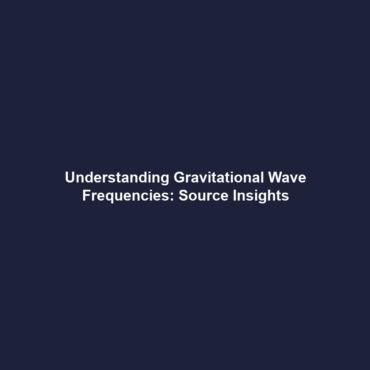Frequency of Gravitational Waves and What Different Frequencies Tell Us About Their Source
Introduction
The study of gravitational waves has emerged as a revolutionary area in astrophysics, fundamentally altering our understanding of the universe. The frequency of gravitational waves is a critical aspect, providing insights into their sources and the events that generate these ripples in spacetime. Understanding gravitational wave frequencies is essential not only for astrophysical research but also for enhancing our comprehension of cosmic phenomena such as black hole mergers and neutron star collisions. This article delves into the significance of gravitational wave frequency and what different frequencies tell us about their sources.
Key Concepts of Gravitational Waves
Understanding Gravitational Wave Frequencies
Gravitational waves are produced by the acceleration of massive objects, resulting in fluctuations in spacetime. The frequency of these waves is influenced by various factors, including the mass, speed, and nature of the source. For instance:
- Low-Frequency Waves: These typically arise from massive objects like supermassive black holes merging, providing a unique perspective on the dynamics of large-scale cosmic structures.
- High-Frequency Waves: These are often associated with smaller, more chaotic events, such as neutron star mergers, giving insight into extreme states of matter and fundamental physics.
Interpreting Frequency Data
Analyzing different frequency signals allows scientists to reconstruct the events that generated them, leading to profound discoveries about the nature of gravitational wave sources. The Fourier Transform is a mathematical tool frequently employed to decompose the gravitational wave signals into their constituent frequencies, revealing critical information about the origins and characteristics of these cosmic events.
Applications and Real-World Uses
The frequency of gravitational waves is pivotal in various scientific fields. Here are some key applications:
- Astronomical Observations: By analyzing gravitational wave frequencies, researchers can identify and study rare astrophysical events that are otherwise undetectable.
- Test of General Relativity: Variations in wave frequency can help test Einstein’s theories in extreme conditions, enhancing our understanding of fundamental physics.
- Cosmic Distance Measurement: Gravitational wave signals can serve as unique standard candles, helping to measure distances in the universe, which is critical for cosmological studies.
Current Challenges
Despite significant advancements in the study of gravitational waves, several challenges remain:
- Noise and Interference: Separating gravitational wave signals from background noise remains a significant hurdle in capturing accurate data.
- Limited Detection Capabilities: Current detectors like LIGO and Virgo have frequency limitations that restrict the range of detectable events.
- Data Overload: The vast amounts of data generated require advanced computational techniques for analysis, leading to logistical issues in data management.
Future Research and Innovations
Exciting developments are on the horizon in the field of gravitational wave research:
- Next-Generation Detectors: Future facilities such as the Einstein Telescope and LISA (Laser Interferometer Space Antenna) aim to detect a broader range of frequencies with enhanced sensitivity.
- Machine Learning Applications: Advanced algorithms may help sift through data more efficiently, improving the identification of wave signals and their sources.
- Multimessenger Astronomy: Integrating gravitational wave data with electromagnetic and neutrino observations will allow for a more comprehensive understanding of cosmic events.
Conclusion
Understanding the frequency of gravitational waves is crucial for interpreting the cosmic events that generate them. Different frequencies offer a wealth of information about their sources, from massive black hole mergers to dynamic neutron star collisions. As research continues to progress, it is essential to address existing challenges and leverage new technologies to unlock the mysteries of the universe. For further exploration, consider checking out our articles on neutron stars and black hole mergers for additional insights.

Leave a Reply